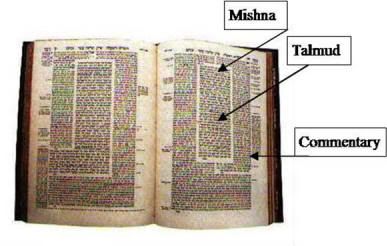(found at Patheos)Christians often say that Jews are under the law and that Christianity is about mercy and freedom from the law. Are Jews under the law? Well, it depends on how you define law? And what exactly do you mean by under? And what would Rabbi Akiva say about that? How about Hillel? And here in Torah it says we are all free …
Pull up a chair. Have a glass of wine. This will take some time.
'The Talmud' is often talked about as if it is one thing. But it is more like an encyclopedia than it is like a book. It is more like - say - the Congressional Record than it is a book of law. It does have laws in it. It also has recipes. It has a few ghost stories. It has recommendations to look after your health. It has arguments about whether or not a certain oven is or isn't properly kosher, together with a story of divine intervention - which is dismissed as irrelevant!
The compilation of the Talmud took several centuries, and it isn't really quite done, exactly. There are also two versions which aren't exactly the same, so which Talmud? In English print editions, it is usually at least 28 volumes, sometimes more. The Steinsalz edition runs to somewhere over 40 volumes.
It has a volume 1, but it starts in the middle of a discussion. It assumes that everybody involved in the conversation ALREADY knows most of the material and all of the Tanakh (Jewish Bible). It assumes you KNOW things - that you don't know yet. It tells you things you thought you know, and reveals that you didn't really get it AT ALL. It spends about 20 pages on what you should do if you find something that someone lost. Maybe it was 40 pages. A lot. The core of it is mostly Hebrew, but with a lot of Aramaic - and some occasional Greek.
One of the earlier commentaries which is invariably included with modern print editions was made over a thousand years ago, in what is now France: even then, some of the terminology needed to be explained to the 'modern' (eleventh century) reader.
The hand copied editions always started on page 2 in each major section (named). The first print edition began with page 2. Every edition has exactly the same material on the same 'page' - which sometimes means 'Bava Kamma page 38b' goes on for six or seven physical pages, depending on the commentaries. Every set of Talmud always begins on page 2, because knowledge is never complete, and never WILL be complete, and there really is no place to start: it is the sea of Talmud; you just start where you are.
h**p://www.sefaria.org/Bava_Metzia.2a.1?lang=b ... l&lang2=en
There's a taste. You can't immediately tell (without knowing it) but most of the people who are 'talking' and 'arguing' with each other, did not live during the same time periods. This discussion crosses time (several centuries) and space (from Israel to Babylonia and back).
